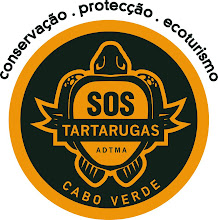Ontem, dia 30 de Setembro, durante a época de desova, os responsáveis da construção do hotel Meliá Dunas Beach começaram a ocupação da praia que fica em frente ao hotel. As obras representam a escavação de buracos de 4 metros quadrados e um quase 1 metro de profundidade com máquinas escavadoras pesadas. Estes buracos encontram-se a uma distância de aproximadamente 27 metros da linha da maré alta, que é dentro de uma área declarada Área Protegida pelo Governo de Cabo Verde
Yesterday, September 30, during the turtle nesting season, those responsible for the construction of the Meliá Dunas Beach began construction works on the beach which is opposite the hotel. The works include digging meter deep and four square meters wide holes with heavy excavators. These holes are located at a distance of approximately 27 meters from the high tide line, which is within an area declared a Protected Area by the Government of Cape Verde.
 |
| In the nesting zone, 27 meters from the sea |
Sendo uma área importante de desova e encontrando-se ainda no fim da temporada de nidificação da Tartaruga Cabeçuda, os responsáveis da monitorização e proteção desta espécie (SOS Tartarugas, DGA and AP) nunca foram contatados pela construtora ou as autoridades responsáveis pelo licenciamento para verificar a presença de ninhos na área de intervenção.
This beach is still an important nesting area and we are still in the loggerhead nesting season. Those responsible for monitoring and protection of this species (SOS Tartarugas, DGA and AP) were not contacted by the builder or the authorities responsible for issuing permits about the presence of nests in this area.
A escavação na praia com o desconhecimento da situação dos ninhos pode ter consequências graves. Remover a areia pode significar a destruição imprudente de ninhos duma espécie protegida nacional e internacionalmente. Não só isso, os buracos permanecem descobertos durante noite e dia, fazendo com que qualquer tartaruga adulta possa cair pera dentro dos mesmos, enquanto procura um local ideal para a desova. O mesmo pode acontecer com os filhotes, situação que aumentaria as probabilidades de ser predados por caranguejos ou cães.
This excavation of the beach without knowing the location of nests can have serious consequences. The removal of sand can mean the destruction of the nests of a national and internationally protected species. Not only that, but the holes remain uncovered during night and day, meaning an adult turtle could fall into the hole while looking for an place to nest. The same could happen with the hatchlings, a situation that would increase the odds of being preyed upon by crabs or dogs.
 |
| Holes left open day and night. |
Os promotores da construção do novo hotel, o “The Resort Group”, e os responsáveis das obras têm conhecimento e as informações necessárias sobre a desova da Tartaruga Cabeçuda e do seu estado de proteção em toda a ilha e, mais especificamente, na praia de Algodoeiro.
The developers, The Resort Group, and the construction company have full knowledge and information about the nesting of loggerheads and their state of protection across the island and more specifically, on Algodoeiro beach.
ADTMA – SOS Tartarugas tem questionado as autoridades ambientais sobre a existência de licenciamento para levar a cabo estas obras na praia durante a época de desova. Se essa licença existe, as autoridades competentes deviam ter restringido a época de construção e obrigar a construtora a informar-se sobre o estado da desova nessa área.
ADTMA – SOS Tartarugas have asked the environmental authorities about the existence of a license to carry out these works on the beach during the nesting season. If such license exists, it is our belief that the authorities should have restricted the time of construction (i.e. AFTER the nesting and hatching season) and require the contractor to enquire about the status of nests in this area.
SOS Tartarugas fica sempre disponível para informar e aconselhar aos promotores sobre as atividades relacionadas com o estado da desova da Tartaruga Cabeçuda e a legislação existente que tem como objetivo a proteção desta espécie, assim como as regulamentações sobre as Áreas Protegidas.
SOS Tartarugas is always available to advise developers on activities that can affect nesting turtles, the existing legislation which aims to protect this species, as well as regulations regarding the Protected Areas.
Só duas dias antes do início da ocupação da praia, foi encontrado um ninho eclodido na área, e durante a noite do dia 30 de Setembro uma tartaruga desovou apenas 10 metros afastada do que, posteriormente, passou a ser caminho para escavadoras pesadas.
Only two days before the construction began we found a hatched nest in the area, and during the night of September 30 a turtle spawned only 10 meters away from where the heavy excavators had been digging.
 |
| A nest only ten meters from the open holes |



















